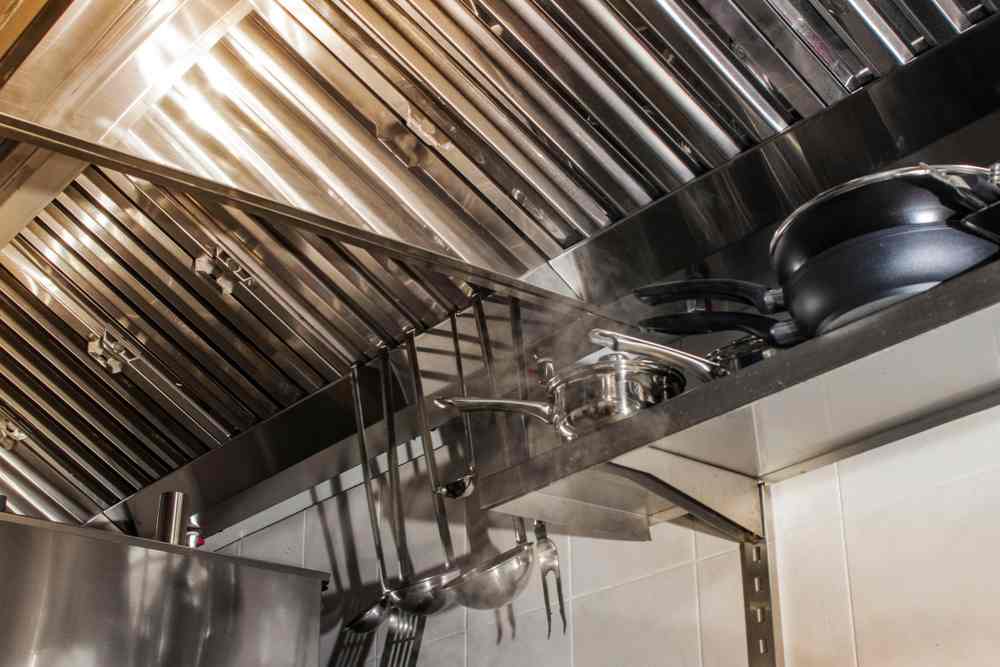How to DIY Clean Kitchen Exhaust

Keeping your kitchen exhaust clean is essential for maintaining a healthy and safe cooking environment. Over time, grease and grime can accumulate in the exhaust system, leading to reduced efficiency and increased fire hazards. While hiring professionals to clean your kitchen exhaust is an option, it can be costly. In this article, we will guide you through the process of DIY cleaning your kitchen exhaust, providing valuable insights and step-by-step instructions to ensure a thorough and effective cleaning.
Ontario-wide Kitchen Exhaust and Hood Cleaning – Best prices and service guaranteed.
The Importance of Cleaning Kitchen Exhaust
Before diving into the cleaning process, it’s crucial to understand why cleaning your kitchen exhaust is so important. Here are a few key reasons:
- Fire Safety: Grease buildup in the exhaust system can become a significant fire hazard. According to the National Fire Protection Association, cooking equipment is the leading cause of home structure fires, and a dirty kitchen exhaust is often the culprit.
- Air Quality: A dirty kitchen exhaust can release harmful pollutants into the air, affecting the indoor air quality of your home. This can lead to respiratory issues and other health problems.
- Efficiency: A clean kitchen exhaust system operates more efficiently, allowing for proper ventilation and preventing the accumulation of heat and odors in your kitchen.
Ontario-wide Kitchen Exhaust and Hood Cleaning – Best prices and service guaranteed.
Gather the Necessary Tools and Equipment
Before starting the cleaning process, make sure you have the following tools and equipment:
- Protective gear: Wear gloves, safety goggles, and a face mask to protect yourself from grease and cleaning chemicals.
- Degreaser: Choose a degreaser specifically designed for kitchen exhaust cleaning. Look for products that are non-toxic and environmentally friendly.
- Scrub brushes: Have a variety of scrub brushes in different sizes to reach all areas of the exhaust system.
- Buckets: You’ll need a few buckets to hold water, degreaser, and dirty cleaning rags.
- Rags and towels: Use old rags or towels that you don’t mind getting dirty.
- Ladder: Depending on the height of your exhaust system, you may need a ladder to reach certain areas.
Ontario-wide Kitchen Exhaust and Hood Cleaning – Best prices and service guaranteed.
Step-by-Step Cleaning Process
Now that you have all the necessary tools and equipment, let’s dive into the step-by-step cleaning process:
1. Turn off the Power
Before starting any cleaning, ensure that the power to the exhaust system is turned off. This will prevent any accidents or injuries while cleaning.
2. Remove and Clean Filters
The first step is to remove and clean the filters. Follow the manufacturer’s instructions to remove the filters from the exhaust system. Once removed, soak the filters in a mixture of warm water and degreaser. Use a scrub brush to remove any grease and grime. Rinse the filters thoroughly and let them air dry before reinstalling.
Ontario-wide Kitchen Exhaust and Hood Cleaning – Best prices and service guaranteed.
3. Clean the Exhaust Hood
Next, focus on cleaning the exhaust hood. Start by wiping down the exterior of the hood with a damp cloth. Then, apply the degreaser to the interior surfaces of the hood, including the baffles and fan blades. Use a scrub brush to remove any stubborn grease. Rinse with water and wipe dry.
4. Clean the Ductwork
The ductwork is where most of the grease buildup occurs. To clean the ductwork, you’ll need to access it through the access panels or by removing sections of the duct. Use a scrub brush and degreaser to clean the interior surfaces of the ductwork thoroughly. Pay close attention to corners and hard-to-reach areas. Rinse with water and wipe dry before reassembling the ductwork.
5. Clean the Exhaust Fan
Ontario-wide Kitchen Exhaust and Hood Cleaning – Best prices and service guaranteed.
The exhaust fan is another critical component of the kitchen exhaust system that requires regular cleaning. Remove the fan cover and clean it with a damp cloth. Use a scrub brush and degreaser to clean the fan blades and motor. Be careful not to get any water or cleaning solution on the motor. Once cleaned, reassemble the fan cover.
6. Clean the Exterior Vent
Lastly, don’t forget to clean the exterior vent. Remove any debris or obstructions from the vent opening. Use a brush or vacuum cleaner to remove any dirt or dust. Wipe down the vent and cover with a damp cloth to remove any remaining grime.
Maintenance Tips
Ontario-wide Kitchen Exhaust and Hood Cleaning – Best prices and service guaranteed.
Regular maintenance is key to keeping your kitchen exhaust clean and efficient. Here are a few tips to help you maintain a clean kitchen exhaust:
- Clean the filters regularly: Depending on your cooking frequency, clean the filters at least once a month. This will prevent grease buildup and maintain proper airflow.
- Wipe down the exhaust hood: After each cooking session, wipe down the exterior of the exhaust hood to remove any splatters or grease.
- Inspect the ductwork: Periodically inspect the ductwork for any signs of grease buildup or damage. Address any issues promptly to prevent further problems.
- Schedule professional inspections: While DIY cleaning is effective, it’s still recommended to have a professional inspect and clean your kitchen exhaust system at least once a year.
Ontario-wide Kitchen Exhaust and Hood Cleaning – Best prices and service guaranteed.
Cleaning your kitchen exhaust is a crucial task that should not be overlooked. By following the step-by-step process outlined in this article, you can effectively clean your kitchen exhaust system and maintain a safe and healthy cooking environment. Remember to gather the necessary tools and equipment, turn off the power, and clean each component thoroughly. Regular maintenance and professional inspections will ensure the longevity and efficiency of your kitchen exhaust system. Stay safe and happy cleaning!
Learn more about “How to Clean Commercial Kitchen Exhaust” here.
Frequently Asked Questions about How to DIY Clean Kitchen Exhaust

What Tools and Supplies Do I Need to DIY Clean My Kitchen Exhaust?
Before diving into the DIY cleaning process, it’s essential to have the right tools and supplies for an effective and safe cleaning experience. Here’s a list of items you’ll need:
A bucket of warm water
Grease-cutting dish soap or a specialized degreaser
Non-abrasive scrub brush
Sponge
A soft cloth or microfiber towel
Rubber gloves
Safety goggles
Screwdriver (for filter removal, if applicable)
The type of tools may vary slightly based on the specific make and model of your kitchen exhaust system. Be sure to consult your appliance manual for any specialized requirements.
How Do I Safely Remove and Clean the Filters?
First, you’ll want to make sure the exhaust fan is off and that you’re wearing appropriate safety gear, such as rubber gloves and safety goggles. Next, use a screwdriver to remove the screws holding the filters in place (if your model has screws). Carefully slide or pop out the filters.
Once removed, soak the filters in a mixture of warm water and grease-cutting dish soap. You can also use a specialized kitchen degreaser for this purpose. Allow the filters to soak for at least 30 minutes to loosen the grease and grime. After soaking, use a non-abrasive scrub brush to remove any remaining residues. Rinse the filters thoroughly with warm water, let them dry completely, and then reassemble them into the hood.
Can I Clean the Inside of the Hood Myself, and How Should I Do It?
Yes, you can clean the inside of the hood yourself, although this is often a bit more labor-intensive than just cleaning the filters. To begin, remove any loose debris with a dry cloth. Prepare a cleaning mixture of warm water and grease-cutting soap or a specialized kitchen degreaser. Use a sponge or cloth to apply the mixture to the interior surfaces of the hood, avoiding any electrical components. You may also use a non-abrasive scrub brush for more stubborn areas.
Be careful not to let any liquid seep into the electrical connections or the motor. Wipe down the interior with a clean, damp cloth to remove any soap residue, followed by a dry cloth to ensure no moisture remains.
Is It Necessary to Clean the Ductwork, and How Can I Do It?
While the ductwork doesn’t typically require as frequent cleaning as the filters or hood, neglecting it altogether can pose a fire hazard. Cleaning the ductwork is more complex and may involve reaching difficult areas. Most experts recommend that this task be done by professionals, especially for ductwork that runs a long distance or has multiple bends.
However, if you insist on doing it yourself, you’ll need additional tools like a high-powered vacuum and a long, flexible brush. After removing the filters, you can reach into the ductwork to remove as much built-up grease and debris as possible. But be warned: This process can be messy and challenging. Incorrectly performing this task could compromise the system’s integrity, so proceed with caution.
What Precautions Should I Take While DIY Cleaning My Kitchen Exhaust?
Safety should always be your first concern when undertaking a DIY project like this. Here are some precautions you should take:
Electrical Safety: Always turn off the exhaust fan and unplug it from the electrical outlet before starting any cleaning process.
Chemical Safety: Wear rubber gloves to protect your hands from harsh cleaning agents. Also, make sure the area is well-ventilated if using strong chemicals.
Physical Safety: Use a sturdy step stool or ladder if you need to reach high places. Never overreach or use an unstable surface to stand on.
Follow Guidelines: Always refer to the manufacturer’s manual for any specific cleaning guidelines or precautions to ensure you won’t void the warranty or cause damage.
By taking the proper precautions and following the recommended procedures, you’ll be well on your way to having a clean, efficient, and safe kitchen exhaust system.






